Integrating Remote Sensing and Aeromagnetic Data for Enhanced Geological Mapping at Wadi Sibrit-Urf Abu Hamam District, Southern Part of Nubian Shield
Abstract
1. Introduction
2. The Study District and Geological Setting
3. Materials and Methods
3.1. Aeromagnetic Data
3.1.1. Aeromagnetic Survey
3.1.2. Reduction to Magnetic Pole (RTP)
3.1.3. Radially Averaged Power Spectrum
3.1.4. Tilt Derivative (TDR)
3.1.5. Euler Deconvolution
3.2. Remote Sensing
Data Processing Methods
3.3. Field and Laboratory Investigations
4. Results
4.1. Magnetic Results
4.1.1. The Total Intensity Magnetic Map
4.1.2. Reduced to the Pole
4.1.3. Low- and High-Pass Map
4.1.4. Tilt Derivative
4.1.5. Euler Deconvolution
4.2. Remote Sensing Results
4.3. Relationship of Mineralization to Lineament Extraction
4.4. Field Observations and Petrographic Investigations
5. Discussion
6. Conclusions
Author Contributions
Funding
Data Availability Statement
Acknowledgments
Conflicts of Interest
References
- Patchett, P.J.; Chase, C.G. Role of transform continental margins in major crustal growth episodes. Geology 2002, 30, 39–42. [Google Scholar] [CrossRef]
- Stern, R.J.; Johnson, P.R.; Kröner, A.; Yibas, B. Neoproterozoic ophiolites of the Arabian-Nubian Shield. In Precambrian Ophiolites and Related Rocks; Kusky, T.M., Ed.; Developments in Precambrian Geology; Elsevier: Amsterdam, The Netherlands, 2004; Volume 13, pp. 95–128. [Google Scholar]
- Nance, R.D.; Murphy, J.B.; Santosh, M. The supercontinent cycle: A retrospective essay. Gondwana Res. 2014, 25, 4–29. [Google Scholar] [CrossRef]
- Li, Z.X.; Bogdanova, S.V.; Collins, A.S.; Davidson, A.; De Waele, B.; Ernst, R.E.; Fitzsimons, I.C.W.; Fuck, R.A.; Gladkochub, D.P.; Jacobs, J. Assembly configuration and break-up history of Rodinia: A synthesis. Precambrian Res. 2008, 160, 179–210. [Google Scholar] [CrossRef]
- Collins, A.S.; Pisarevsky, S.A. Amalgamating eastern Gondwana: The evolution of the Circum-Indian Orogens. Earth-Sci. Rev. 2005, 71, 229–270. [Google Scholar]
- Bentor, Y.K. The crustal evolution of the Arabo-Nubian massif with special reference to the Sinai Peninsula. Precambrian Res. 1985, 28, 1–74. [Google Scholar] [CrossRef]
- Abdelsalam, M.G.; Liégeois, J.P.; Stern, R.J. The Saharan Metacraton. J. Afr. Earth Sci. 2002, 34, 119–136. [Google Scholar] [CrossRef]
- Johnson, P.R.; Woldhaimanot, B. Development of the Arabian-Nubian Shield: Perspectives on accretion and deformation in the northern East African Orogen and the assembly of Gondwana. In Proterozoic East Gondwana: Supercontinent Assembly and Breakup; Yoshida, M., Dasgupta, S., Windley, B., Eds.; Special Pub. 206; Geological Society of London: London, UK, 2003; pp. 289–325. [Google Scholar]
- Eldosouky, A.M.; Pham, L.T.; Duong, V.H.; Kemgang Ghomsi, F.E.; Henaish, A. Structural interpretation of potential field data using the enhancement techniques: A case study. Geocarto Int. 2022, 37, 16900–16925. [Google Scholar] [CrossRef]
- Kharbish, S.; Eldosouky, A.M.; Amer, O. Integrating mineralogy, geochemistry and aeromagnetic data for detecting Fe–Ti ore deposits bearing layered mafic intrusion, Akab El-Negum, Eastern Desert. Egypt. Sci. Rep. 2022, 12, 15474. [Google Scholar] [CrossRef]
- Mahdi, A.M.; Eldosouky, A.M.; El Khateeb, S.O.; Youssef, A.M.; Saad, A.A. Integration of remote sensing and geophysical data for the extraction of hydrothermal alteration zones and lineaments; Gabal Shilman basement area, Southeastern Desert, Egypt. J. Afr. Earth Sci. 2022, 194, 104640. [Google Scholar] [CrossRef]
- Stern, R.J. Crustal evolution in the East African Orogen: A neodymium isotopic perspective. J. Afr. Earth Sci. 2002, 34, 109–117. [Google Scholar] [CrossRef]
- de Wit, M.J.; Chewaka, S. Plate tectonic evolution of Ethiopia and the origin of its mineral deposits: An overview. In Plate Tectonics and Metallogenesis: Some Guidelines to Ethiopian Mineral Deposits; Ethiopian Institute of Geological Survey: Abbis Ababa, Ethiopia, 1981; pp. 115–129. [Google Scholar]
- Fowler, A.; Hassen, I.; Hassan, M. Tectonic evolution and setting of the Sa’al Complex, southern Sinai, Egypt: A Proterozoic continental back-arc rift model. J. Afr. Earth Sci. 2015, 104, 103–131. [Google Scholar] [CrossRef]
- Rice, A.N.; Greiling, R.O.; Dardir, A.A.; Rashwan, A.; Sadek, M.F. Pan-African extensional structures in the area south of the Hafafit Antiform, Eastern Desert of Egypt. In Proceedings of the Kolloquium/Afrikagruppe Deutscher Geowissenschaftler, Heidelberg, Germany, 29 June 1990; Volume 1991, pp. 2641–2651. Available online: https://pascal-francis.inist.fr/vibad/index.php?action=getRecordDetail&idt=6368926 (accessed on 22 April 2025).
- Soliman, N.; El-Desoky, H.; Mohamed El Rahmany, M.; Maira, H.; Fahmy, W. ASTER Data and mineral studies for mapping the alteration zones at Wadi Sibrit-Wadi Urf Abu Hamam area, South Eastern Desert, Egypt. Middle East J. Appl. Sci. 2021, 11, 481–521. [Google Scholar]
- Fritz, H.; Abdelsalam, M.; Ali, K.A.; Bingen, B.; Collins, A.S.; Fowler, A.R.; Ghebreab, W.; Hauzenberger, C.A.; Johnson, P.R.; Kusky, T.M.; et al. Orogen styles in the East African Orogen: A review of the Neoproterozoic to Cambrian tectonic evolution. J. Afr. Earth Sci. 2013, 86, 65–106. [Google Scholar] [CrossRef] [PubMed]
- Johnson, P.R.; Andresen, A.; Collins, A.S.; Fowler, A.R.; Fritz, H.; Ghebreab, W.; Kusky, T.; Stern, R.J. Late Cryogenian–Ediacaran history of the Arabian–Nubian Shield: A review of depositional, plutonic, structural, and tectonic events in the closing stages of the northern East African Orogen. J. Afr. Earth Sci. 2011, 61, 167–232. [Google Scholar] [CrossRef]
- Hamimi, Z.; Fowler, A.R.; Liégeois, J.P.; Collins, A.; Abdelsalam, M.G.; Abd El-Wahed, M. (Eds.) The Geology of the Egyptian Nubian Shield; Regional Geology Rviews; Springer Nature: Cham, Switzerland, 2021. [Google Scholar] [CrossRef]
- Stern, R.J.; Johnson, P. Continental lithosphere of the Arabian Plate: A geologic, petrologic, and geophysical synthesis. Earth-Sci. Rev. 2010, 101, 29–67. [Google Scholar] [CrossRef]
- Lasheen, E.S.R.; Mohamed, W.H.; Ene, A.; Awad, H.A.; Azer, M.K. Implementation of petrographical and aeromagnetic data to determine depth and structural trend of Homrit Waggat Area, Central Eastern Desert, Egypt. Appl. Sci. 2022, 12, 8782. [Google Scholar] [CrossRef]
- Hassaan, M.M.; El-Sawy, K.E. Tectonic environments and distribution of gold deposits in the Pan African Nubian Shield, Egypt. Aust. J. Basic Appl. Sci. 2009, 3, 797–809. [Google Scholar]
- Zoheir, B.A. Characteristics and genesis of shear zone-related gold mineralization in Egypt: A case study from the Um El Tuyor mine, south Eastern Desert. Ore Geol. Rev. 2008, 34, 445–470. [Google Scholar] [CrossRef]
- Zoheir, B.A. Transpressional zones in ophiolitic mélange terranes: Potential exploration targets for gold in the South Eastern Desert, Egypt. J. Geochem. Explor. 2011, 111, 23–38. [Google Scholar] [CrossRef]
- Zoheir, B.A.; Lehmann, B. Listvenite–lode association at the Barramiya gold mine, Eastern Desert, Egypt. Ore Geol. Rev. 2011, 39, 101–115. [Google Scholar] [CrossRef]
- Abd El-Wahed, M.A. Oppositely dipping thrusts and transpressional imbricate zone in the Central Eastern Desert of Egypt. J. Afr. Earth Sci. 2014, 100, 42–59. [Google Scholar] [CrossRef]
- Basta, F.F.; Maurice, A.E.; Bakhit, B.R.; Ali, K.A.; Manton, W.I. Neoproterozoic contaminated MORB of Wadi Ghadir ophiolite, NE Africa: Geochemical and Nd and Sr isotopic constraints. J. Afr. Earth Sci. 2011, 59, 227–242. [Google Scholar] [CrossRef]
- Volesky, J.C.; Leybourne, M.I.; Stern, R.J.; Peter, J.M.; Layton-Matthews, D.; Rice, S.; Johnson, P.R. Metavolcanic host rocks, mineralization, and gossans of the Shaib al Tair and Rabathan volcanogenic massive sulphide deposits of the Wadi Bidah Mineral District, Saudi Arabi. Int. Geol. Rev. 2017, 59, 1975–2002. [Google Scholar] [CrossRef]
- Ahmed, A.H.; Gharib, M. Porphyry Cu mineralization in the eastern desert of Egypt: Inference from geochemistry, alteration zones, and ore mineralogy. Arab. J. Geosci. 2016, 9, 179. [Google Scholar] [CrossRef]
- Affleck, J. Magnetic anomaly trend and spacing patterns. Geophysics 1963, 28, 379–395. [Google Scholar] [CrossRef]
- Conoco. Egyptian General Petroleum Corporation—Conoco Coral Geological Map of Egypt, Scale 1:500,000; Conoco: Cairo, Egypt, 1987. [Google Scholar]
- Sabet, A.H. Geological Map of Bur Umm Qubur Sheet Eastern Desert; Internal Report; Geological Survey of Egypt: Cairo, Egypt, 1973; Volume 89. [Google Scholar]
- Aero-Service. Final Operational Report of Airborne Magnetic/Radiation Survey in the Eastern Desert, Egypt, Conducted for the Egyptian General Petroleum Corporation, Aero-Service Division; Western Geophysical Co.: Houston, TX, USA, 1984. [Google Scholar]
- Montaj, O. Geosoft Mapping and Prcessing System; Geosoft Inc.: Toronto, ON, Canada, 2007. [Google Scholar]
- Sharma, P.V. Geophysical Methods in Geology; Elsevier: Amsterdam, The Netherlands, 1985. [Google Scholar]
- Spector, A. Application of Aeromagnetic Data for Porphyry Copper Exploration in Area of Volcanic Cove. In Proceedings of the 45th Annual International Meeting of the SEG, Denver, CO, USA, 12–16 October 1975. [Google Scholar]
- Spector, A.; Grant, F.S. Statistical models for interpreting aeromagnetic Data. Geophysics 1970, 35, 293–302. [Google Scholar] [CrossRef]
- Reford, M.S.; Sumner, J.S. Aeromagnetics. Geophysics 1964, 29, 482–516. [Google Scholar] [CrossRef]
- Miller, H.G.; Singh, V. Potential field tilt—A new concept for location of potential field sources. J. Appl. Geophys. 1994, 32, 213–217. [Google Scholar] [CrossRef]
- Oruç, B.; Keskinsezer, A. Structural setting of the northeastern Biga Peninsula (Turkey) from tilt derivatives of gravity gradient tensors and magnitude of horizontal gravity components. Pure Appl. Geophys. 2008, 165, 1913–1927. [Google Scholar] [CrossRef]
- Jeng, Y.; Lee, Y.L.; Chen, C.Y.; Lin, M.J. Integrated signal enhancements in magnetic investigation in archaeology. J. Appl. Geophys. 2003, 53, 31–48. [Google Scholar] [CrossRef]
- Reid, A.B.; Allsop, J.M.; Granser, H.; Millett, A.T.; Somerton, I.W. Magnetic interpretation in three dimensions using Euler deconvolution. Geophysics 1990, 55, 80–91. [Google Scholar] [CrossRef]
- Abrams, M.J.; Brown, D.; Lepley, L.; Sadowski, R. Remote sensing for porphyry copper deposits in southern Arizona. Econ. Geol. 1983, 78, 591–604. [Google Scholar] [CrossRef]
- Sultan, M.; Arvidson, R.E.; Sturchio, N.C. Mapping of serpentinites in the Eastern Desert of Egypt by using Landsat thematic mapper data. Geology 1986, 14, 995–999. [Google Scholar] [CrossRef]
- Sabins, F.F. Remote sensing for mineral exploration. Ore Geol. Rev. 1999, 14, 157–183. [Google Scholar] [CrossRef]
- Gad, S.; Kusky, T. Lithological mapping in the Eastern Desert of Egypt, the Barramiya area, using Landsat thematic mapper (TM). J. Afr. Earth Sci. 2006, 44, 196–202. [Google Scholar] [CrossRef]
- El-Desoky, H.M.; Tende, A.W.; Abdel-Rahman, A.M.; Ene, A.; Awad, H.A.; Fahmy, W.; El-Awny, H.; Zakaly, H.M.H. Hydrothermal Alteration Mapping Using Landsat 8 and ASTER Data and Geochemical Characteristics of Precambrian Rocks in the Egyptian Shield: A Case Study from Abu Ghalaga, Southeastern Desert, Egypt. Remote Sens. 2022, 14, 3456. [Google Scholar] [CrossRef]
- Gad, S.; Kusky, T. ASTER spectral ratioing for lithological mapping in the Arabian–Nubian shield, the Neoproterozoic Wadi Kid area, Sinai, Egypt. Gondwana Res. 2007, 11, 326–335. [Google Scholar] [CrossRef]
- Amer, R.; Kusky, T.; Ghulam, A. Lithological mapping in the Central Eastern Desert of Egypt using ASTER data. J. Afr. Earth Sci. 2010, 56, 75–82. [Google Scholar] [CrossRef]
- Abdeen, M.M.; Allison, T.K.; Abdelsalam, M.G.; Stern, R.J. Application of ASTER band-ratio images for geological mapping in arid regions; the Neoproterozoic Allaqi Suture, Egypt. Abstr. Program Geol. Soc. Am. 2001, 3, 289. [Google Scholar]
- Gabr, S.S.; Hassan, S.M.; Sadek, M.F. Prospecting for new gold-bearing alteration zones at El-Hoteib area, South Eastern Desert, Egypt, using remote sensing data analysis. Ore Geol. Rev. 2015, 71, 1–13. [Google Scholar] [CrossRef]
- Abrams, M.; Hook, S. ASTER Users Handbook (Version 2); Jet Propulsion Laboratory: Pasadena, CA, USA, 1983. Available online: https://lpdaac.usgs.gov/documents/262/ASTER_User_Handbook_v2.pdf (accessed on 22 April 2025).
- Aggarwal, A.; Garg, R.D. Systematic approach towards extracting endmember spectra from hyperspectral image using PPI and SMACC and its evaluation using spectral library. Appl. Geomat. 2015, 7, 37–48. [Google Scholar] [CrossRef]
- Devi, M.V.; Kalaivani, S. Endmember estimation using fuzzy grade of membership and spectral matching. IEEE Access 2023, 11, 95315–95333. [Google Scholar] [CrossRef]
- Shebl, A.; Abdellatif, M.; Abriha, D.; Dawoud, M.; Ali, M.A.H.; Mahmoud, A.S.; Kristály, F.; Csámer, Á. EnMap hyperspectral data in geological investigations: Evaluation for lithological and hydrothermal alteration mapping in Neoproterozoic rocks. Gondwana Res. 2025, 143, 91–124. [Google Scholar] [CrossRef]
- O’leary, D.W.; Friedman, J.D.; Pohn, H.A. Lineament, linear, lineation: Some proposed new standards for old terms. Geol. Soc. Am. Bull. 1976, 87, 1463–1469. [Google Scholar] [CrossRef]
- Hung, L.Q.; Batelaan, O.; Smedt, F. Lineament extraction and analysis, comparison of LANDSAT ETM and ASTER imagery. Case study: Suoimuoi tropical karst catchment, Vietnam. In Remote Sensing for Environmental Monitoring, GIS Applications, and Geology V; SPIE: Bellingham, WA, USA, 2005; Volume 5983. [Google Scholar] [CrossRef]
- Gass, I.G. Upper Proterozoic (Pan-African) Calc-Alkaline Magmatism in North-Eastern Africa and Arabia; Thorpe, R.S., Ed.; John Wiley and Sons: New York, NY, USA, 1982. [Google Scholar]
- Kroner, A.; Krüger, J.; Rashwan, A.E.A.A. Age and tectonic setting of granitoid gneisses in the Eastern Desert of Egypt and south-west Sinai. Int. J. Earth Sci. 1994, 83, 502–513. [Google Scholar] [CrossRef]
- Abdelsalamand, M.G.; Stern, R.J. Sutures and shear zones in the Arabian-Nubian Shield. J. Afr. Earth Sci. 1996, 23, 289–310. [Google Scholar] [CrossRef]
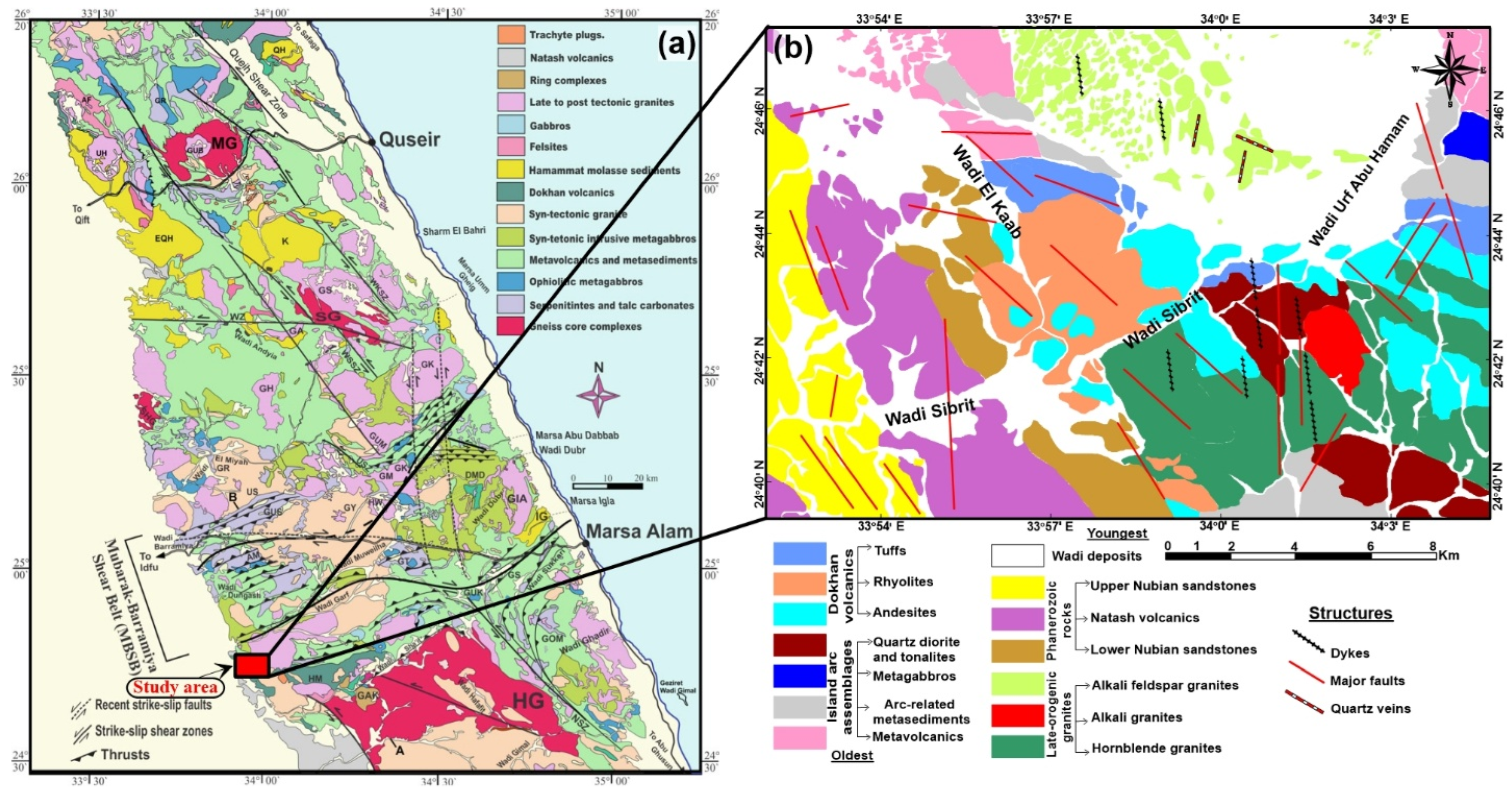
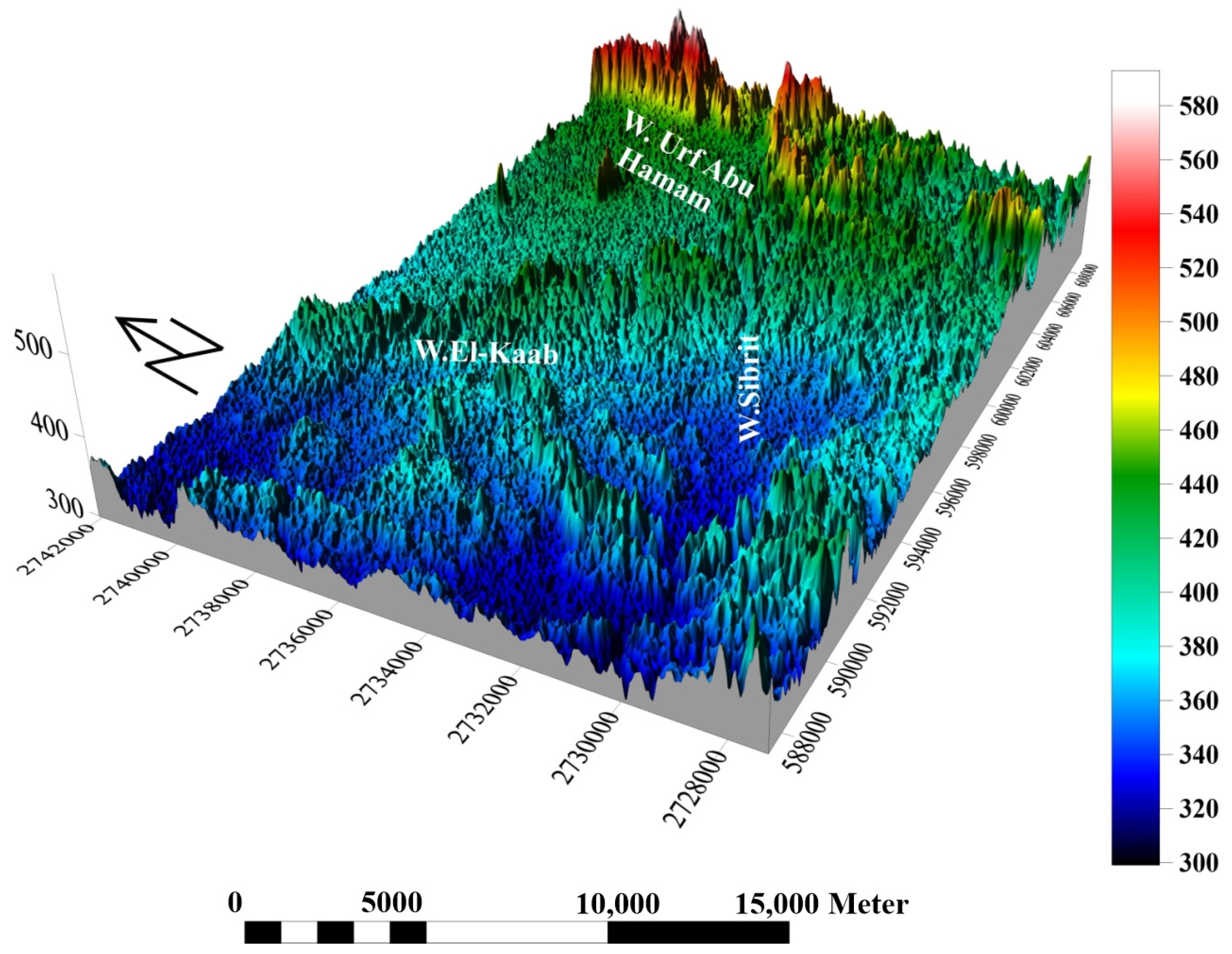
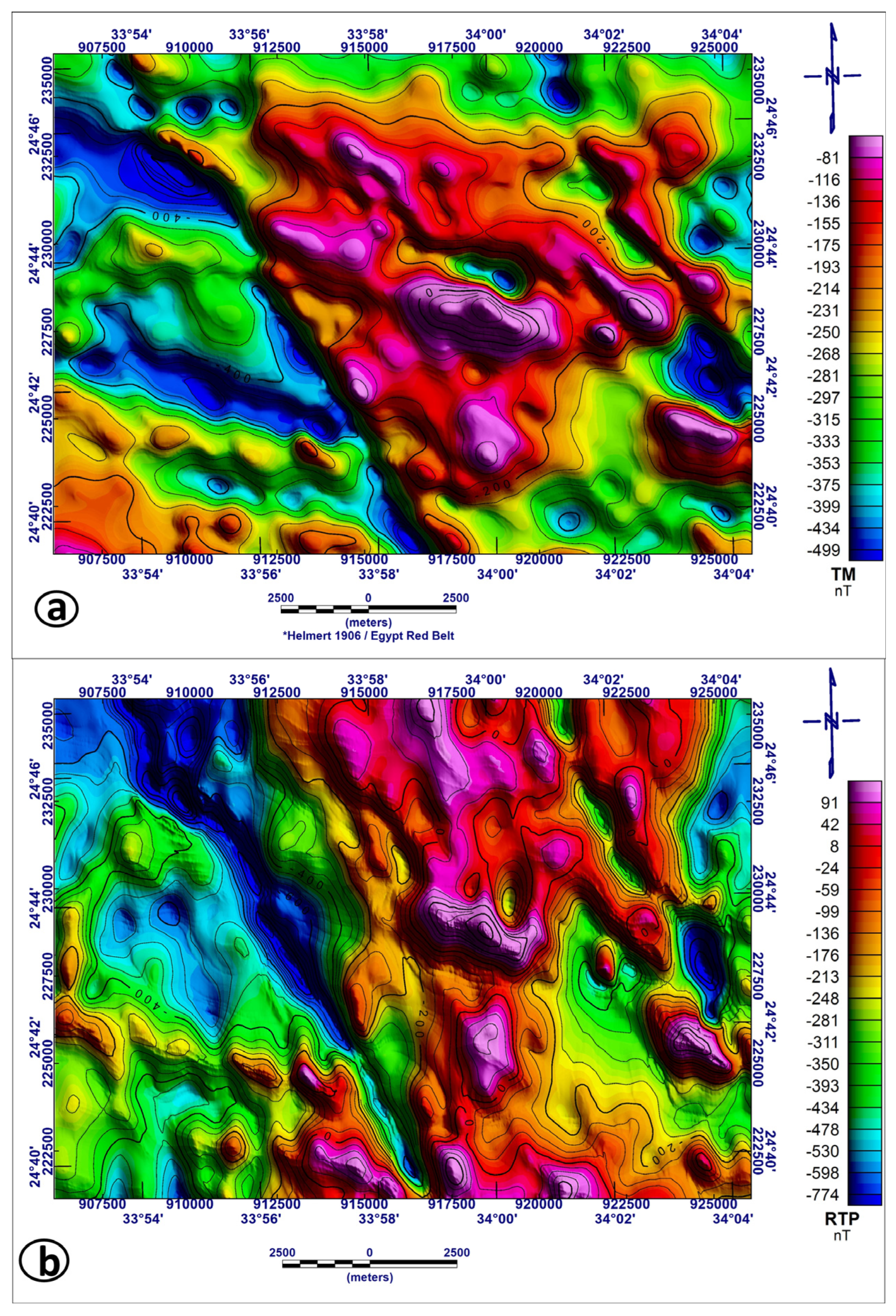
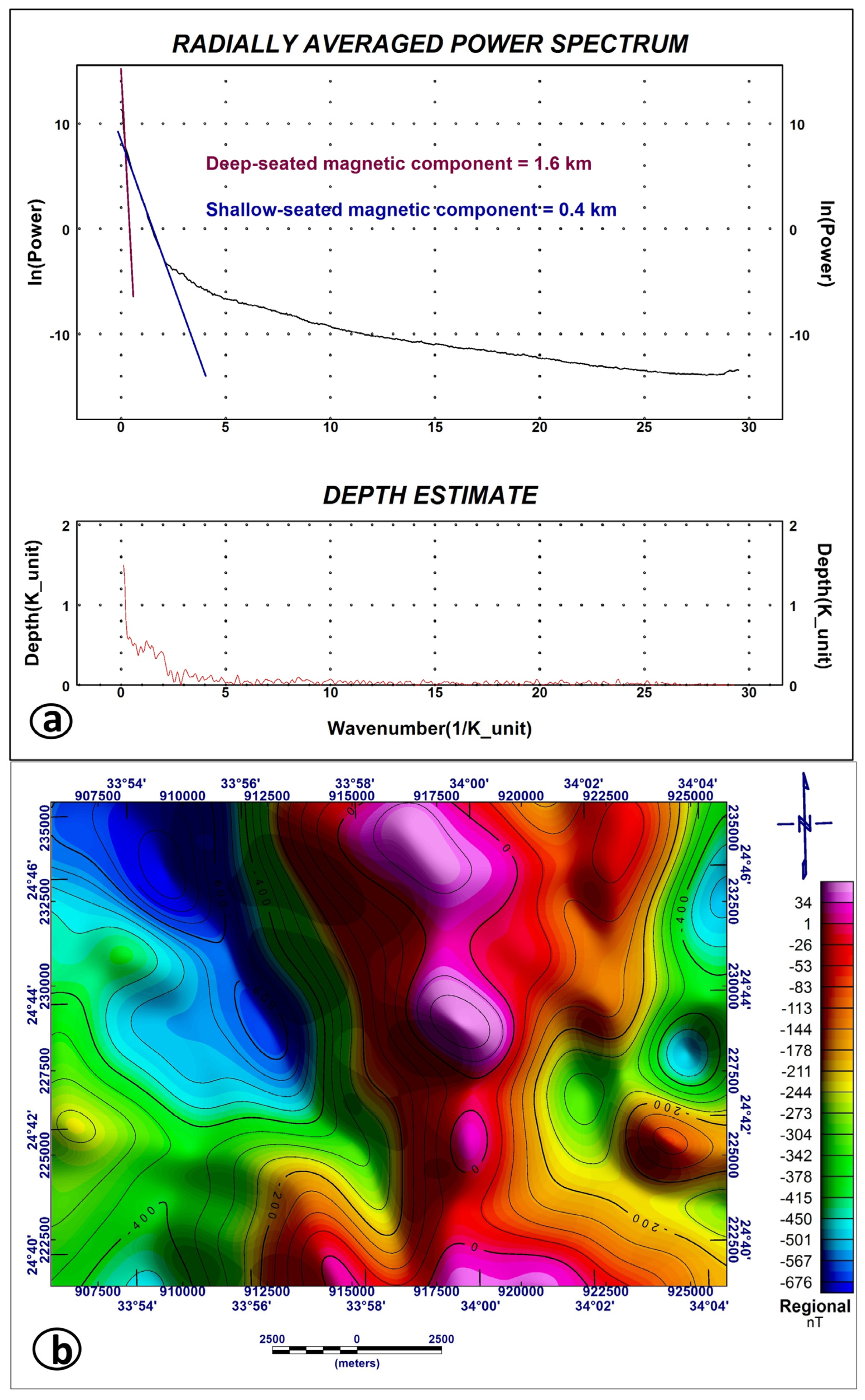
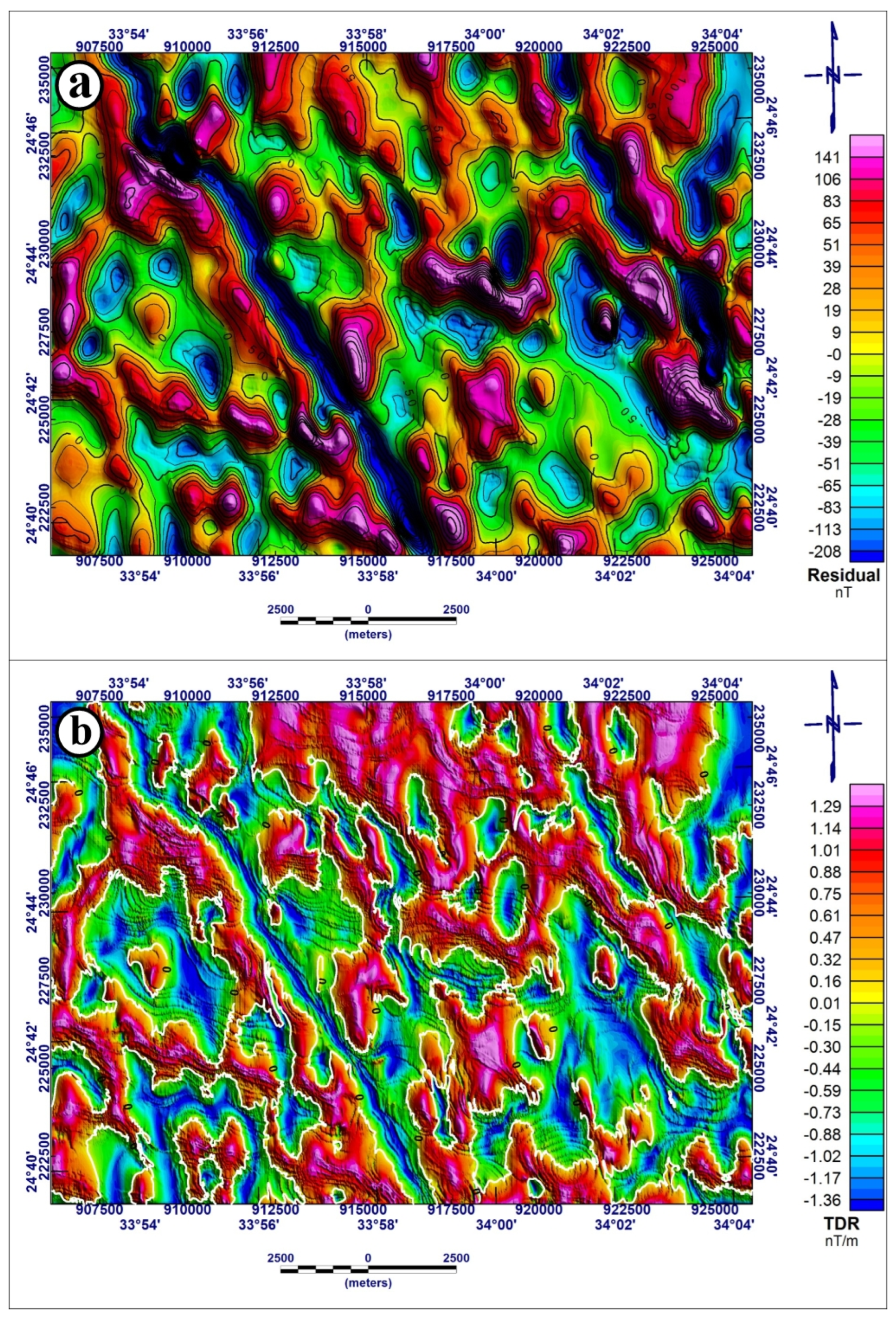
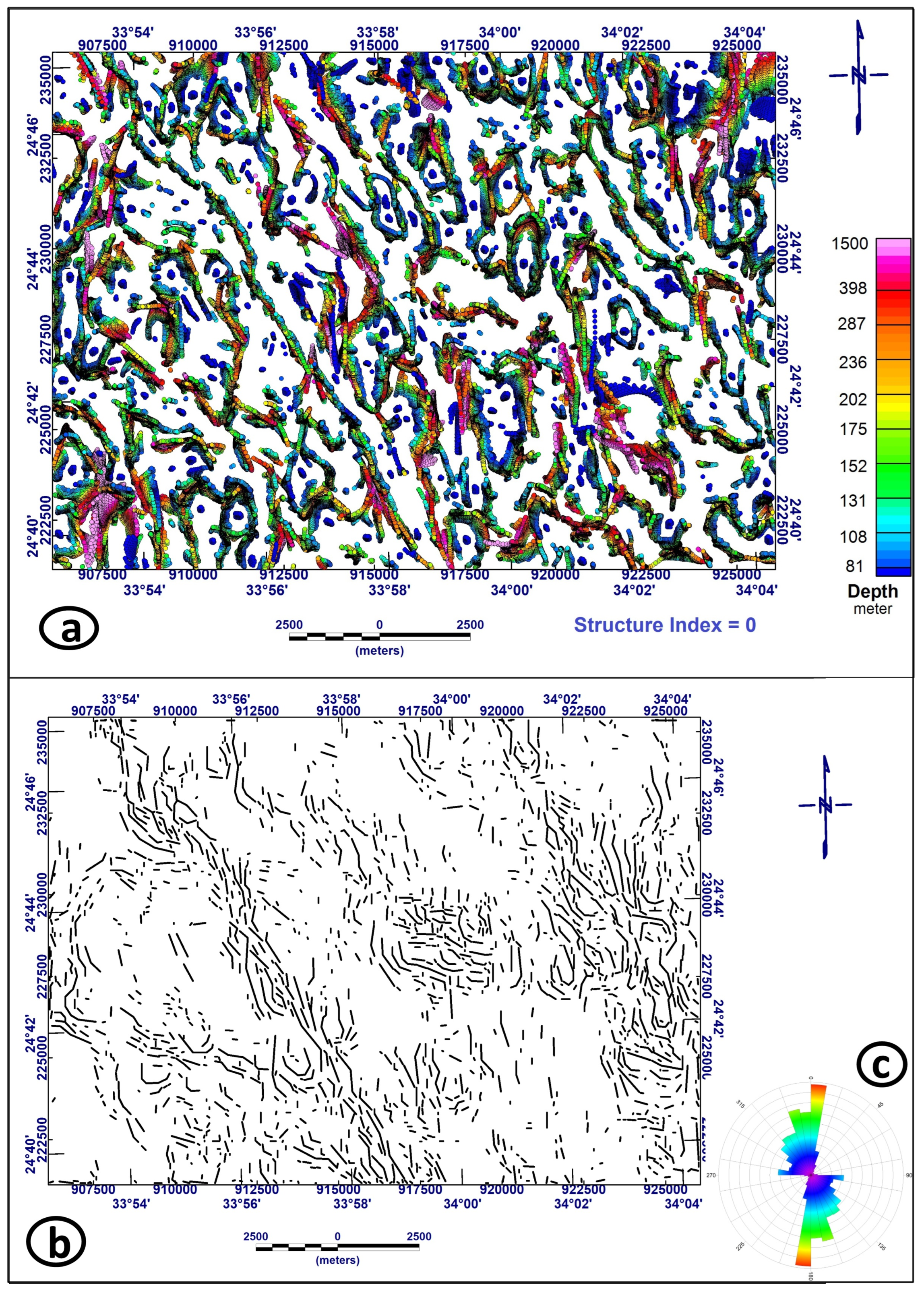
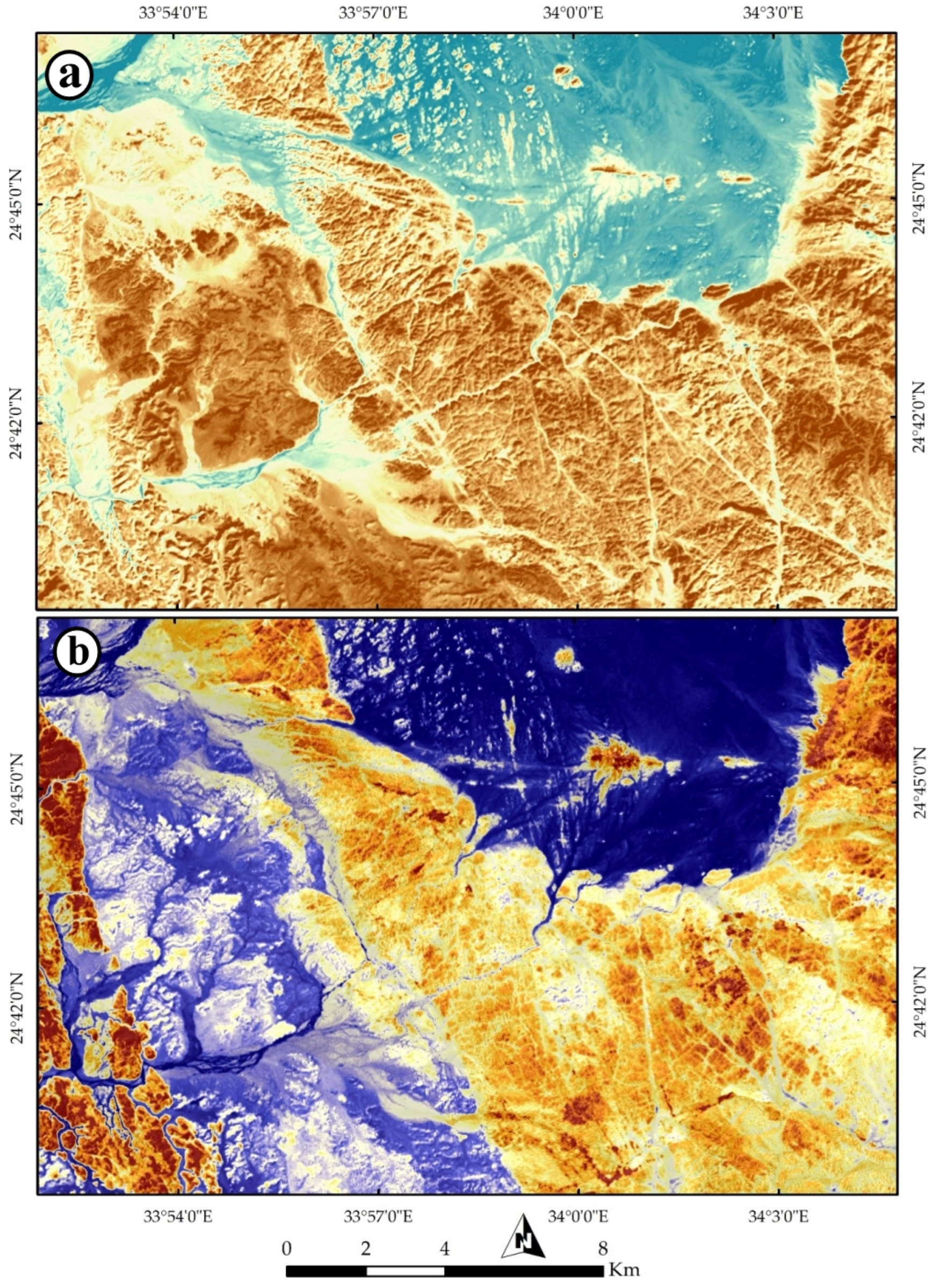
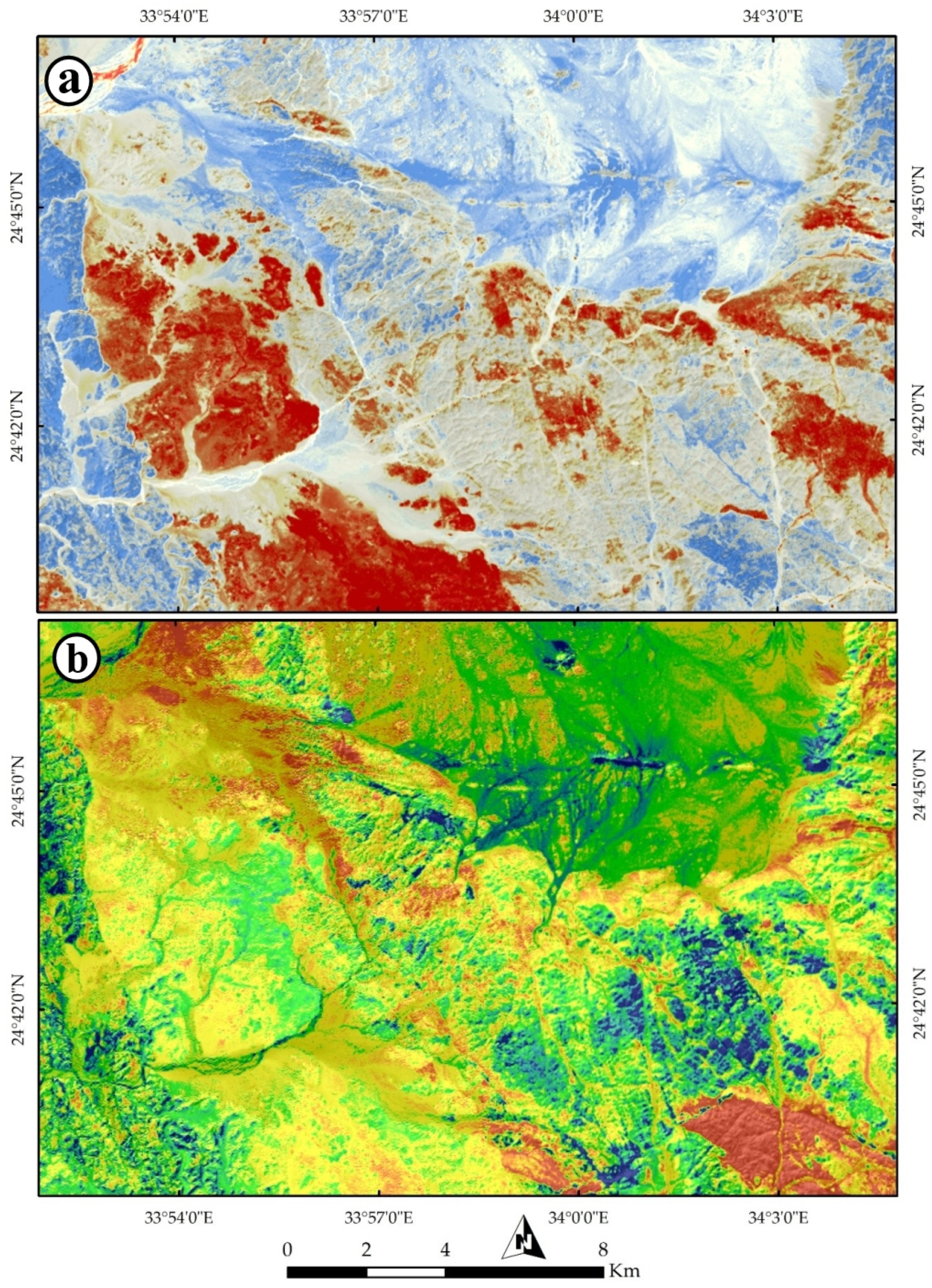

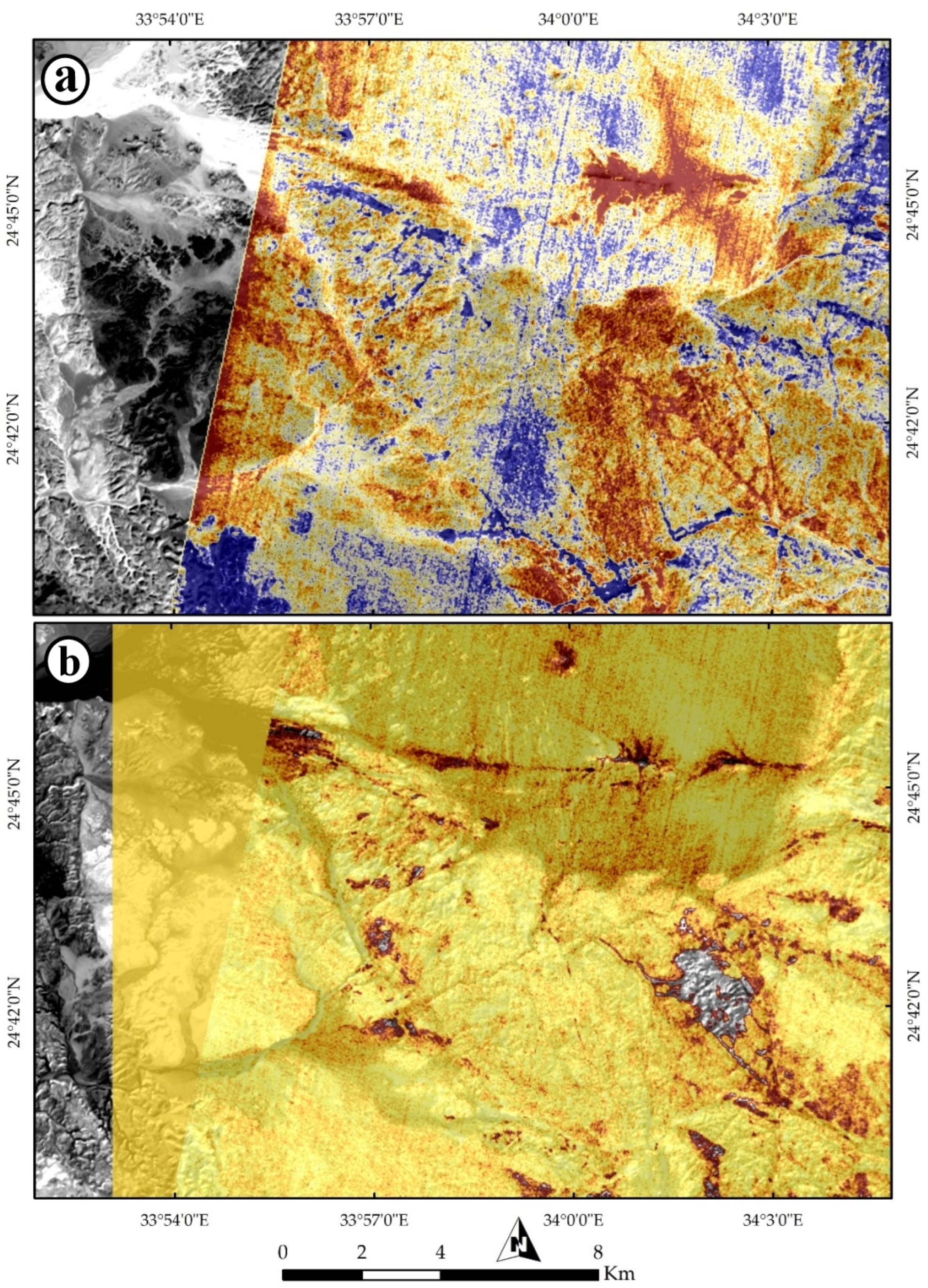
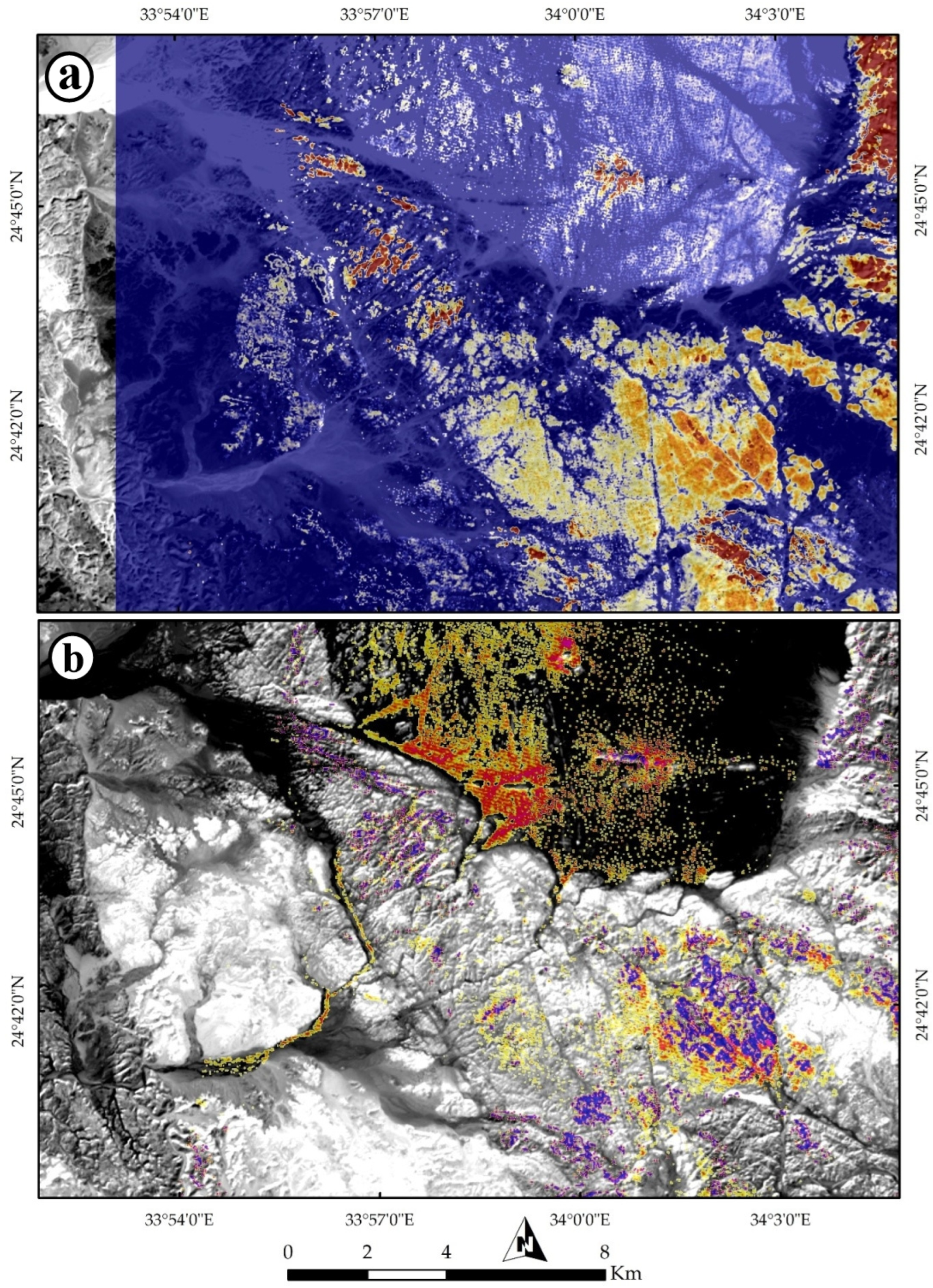
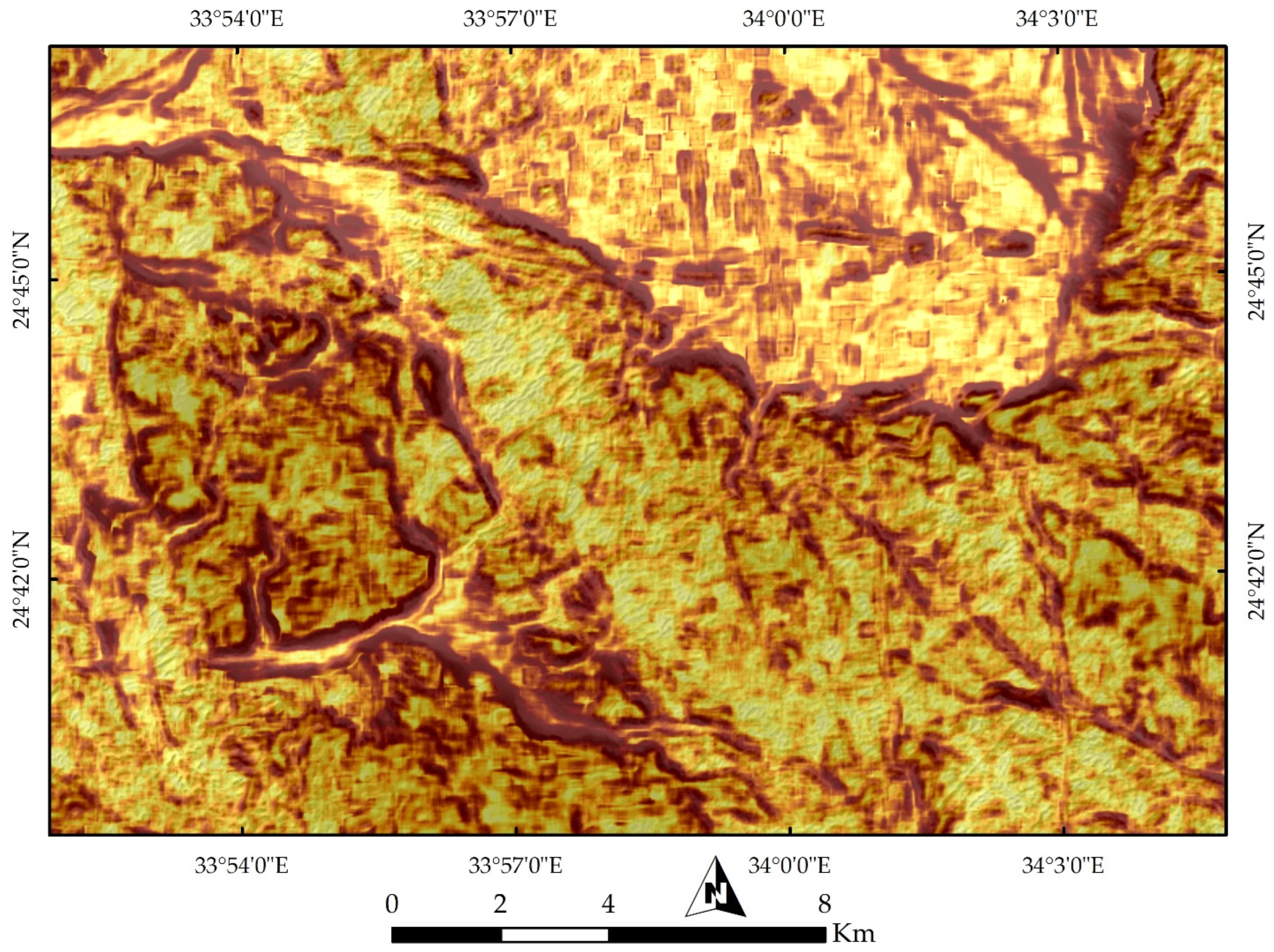
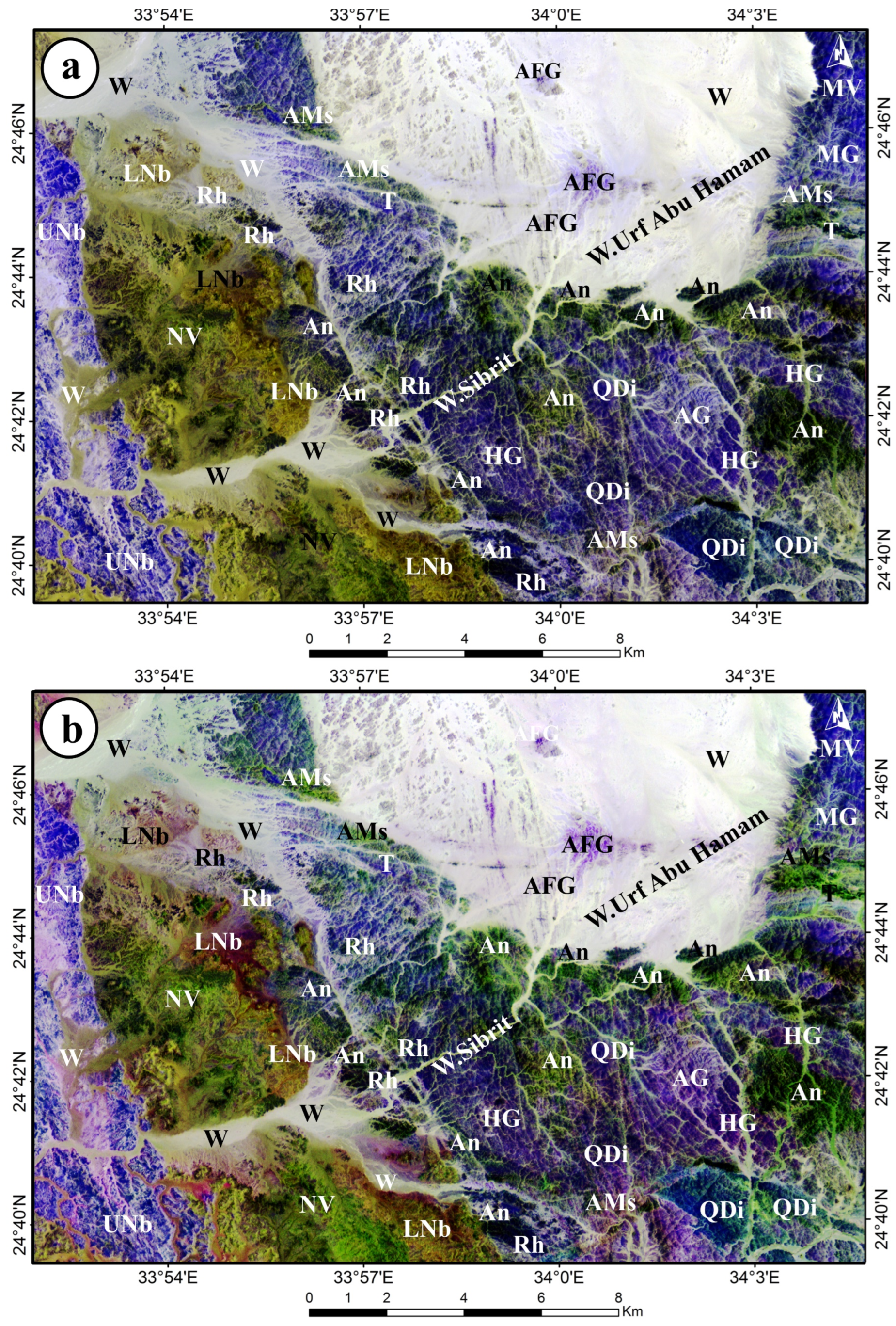
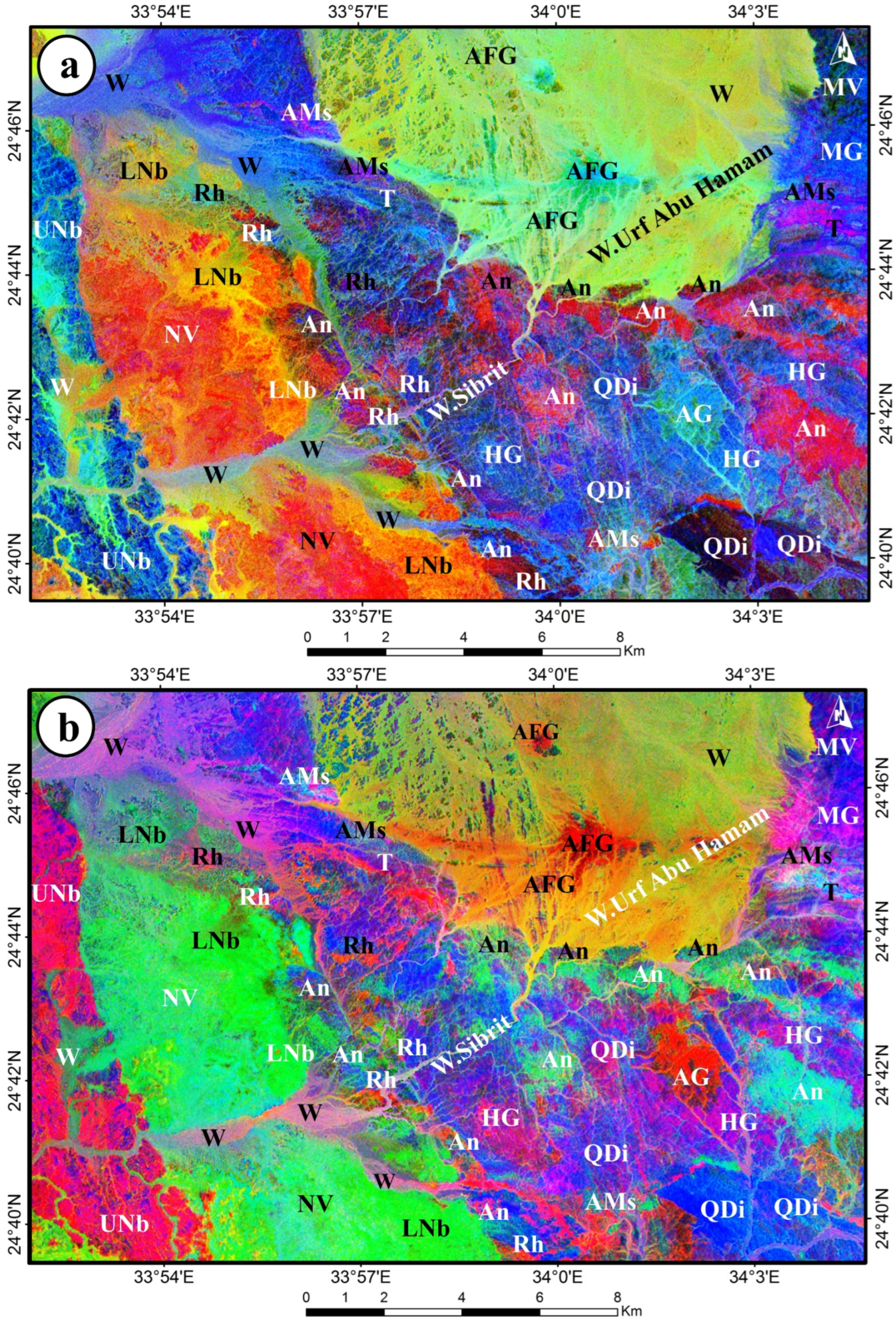
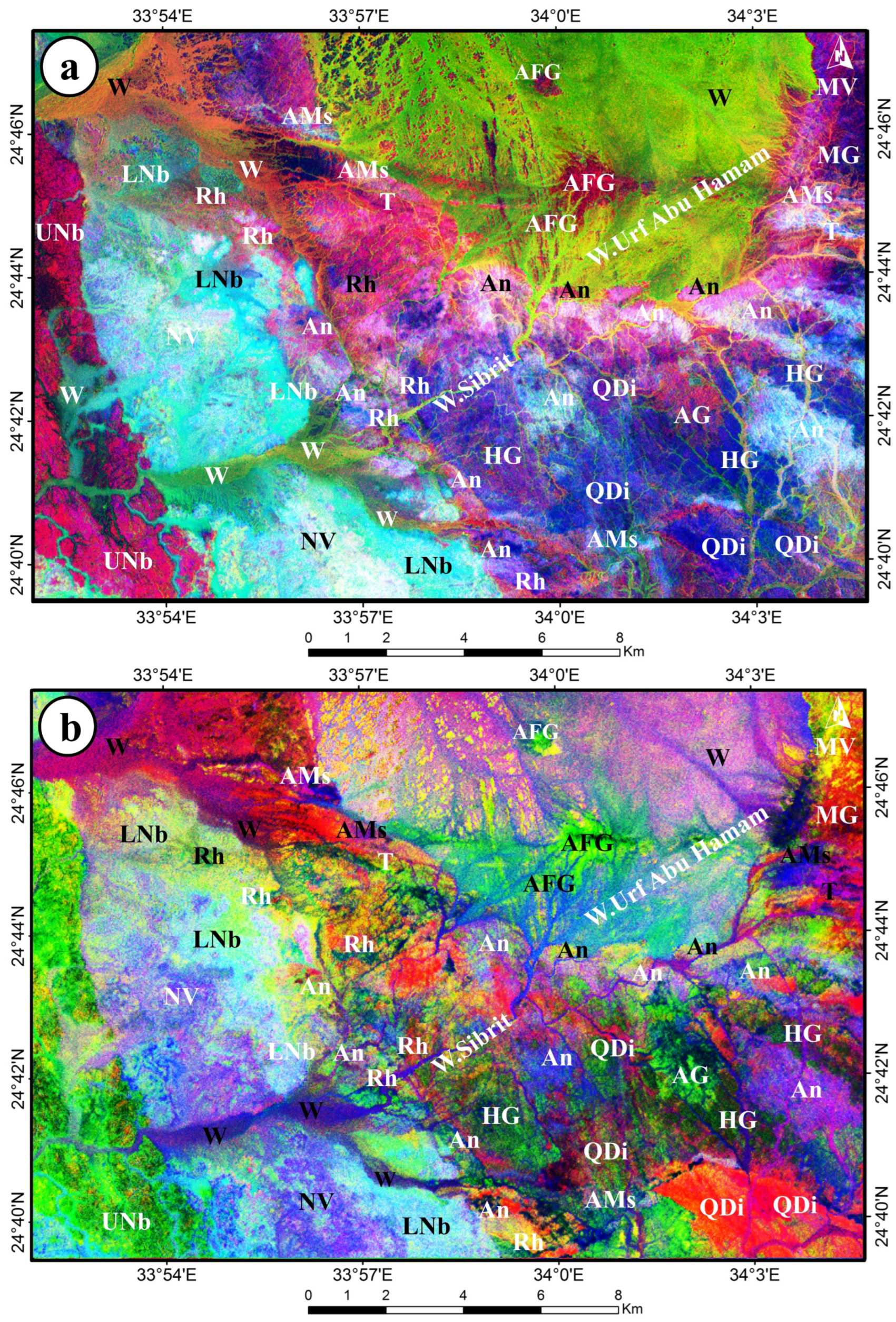
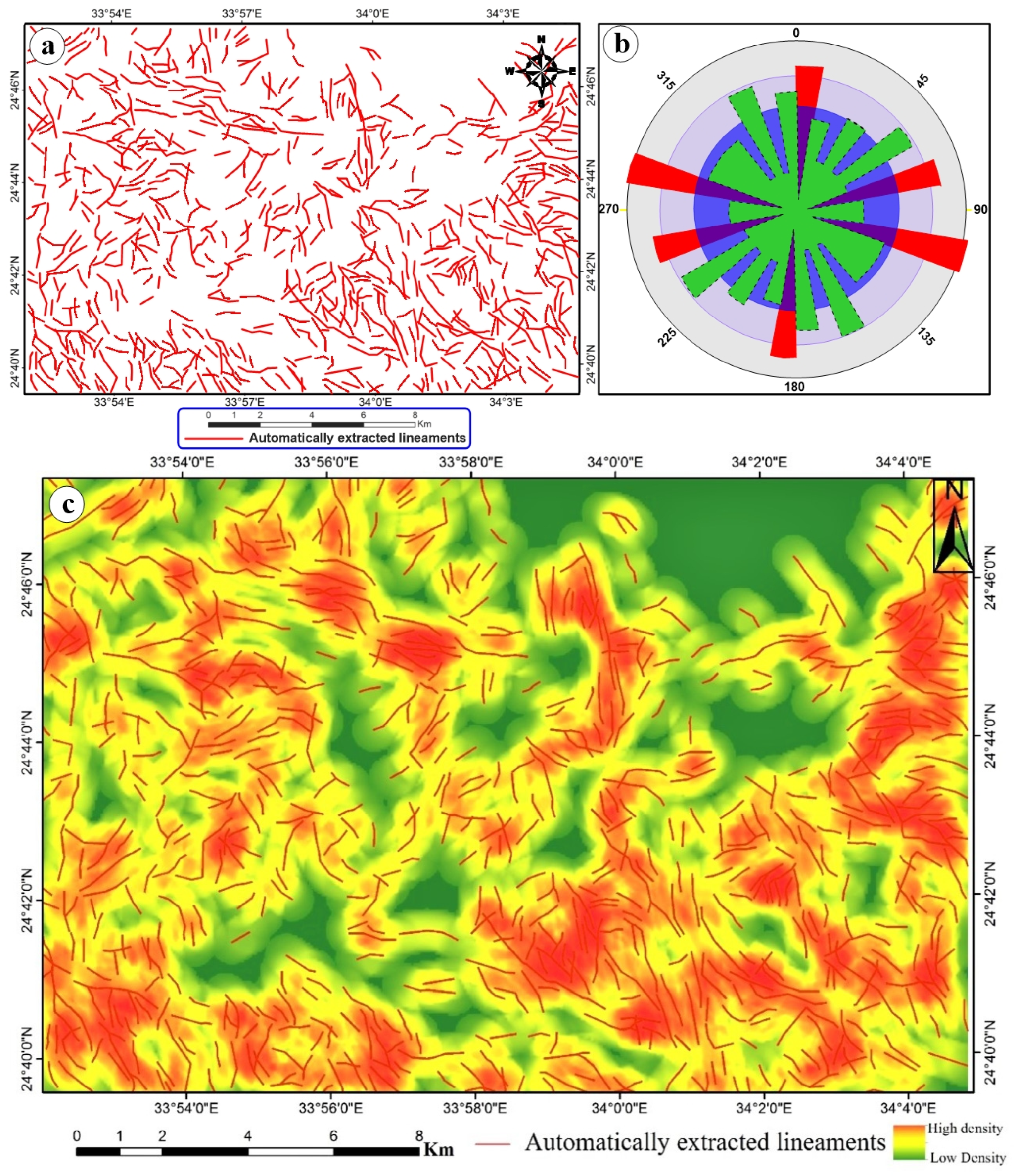
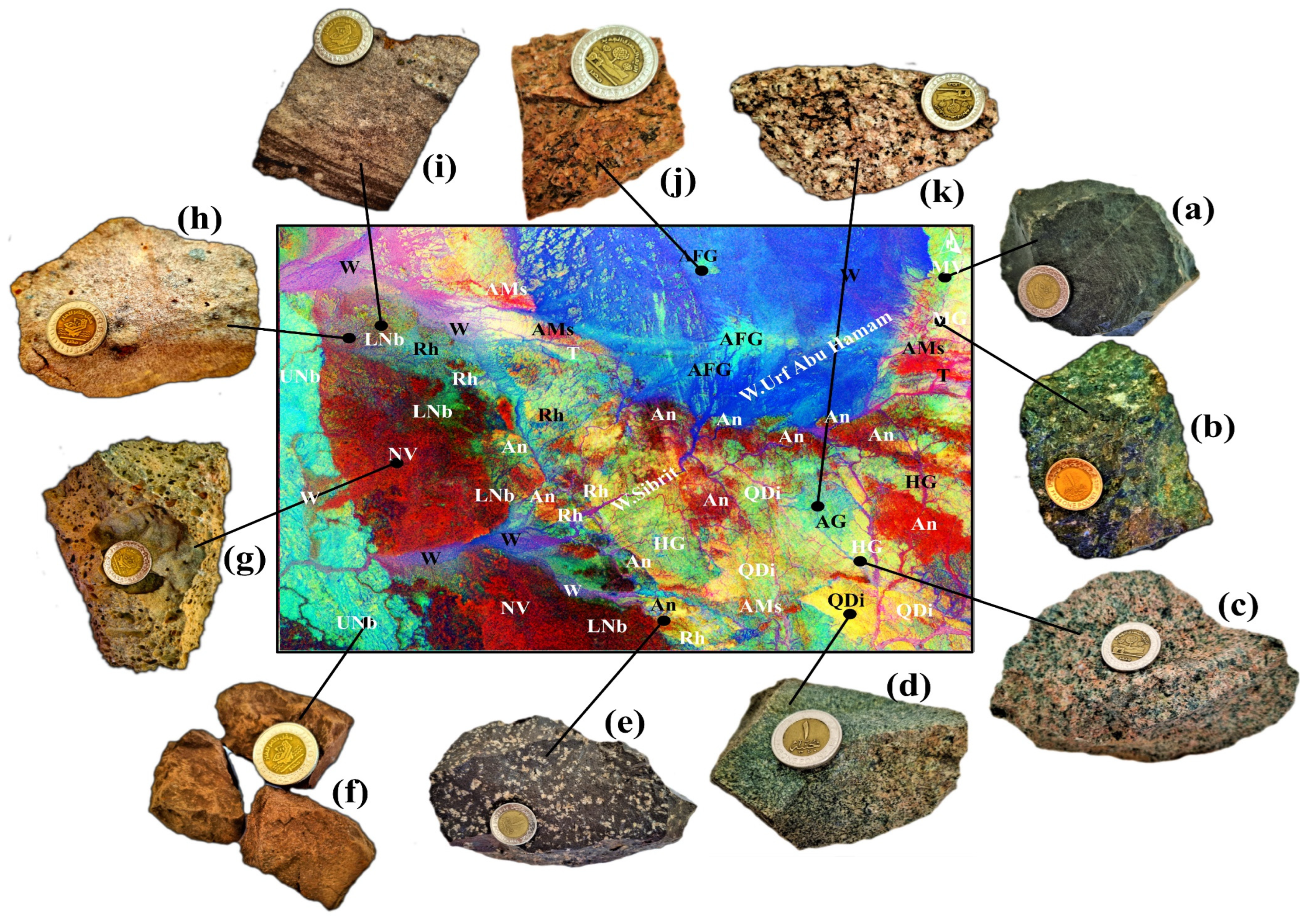
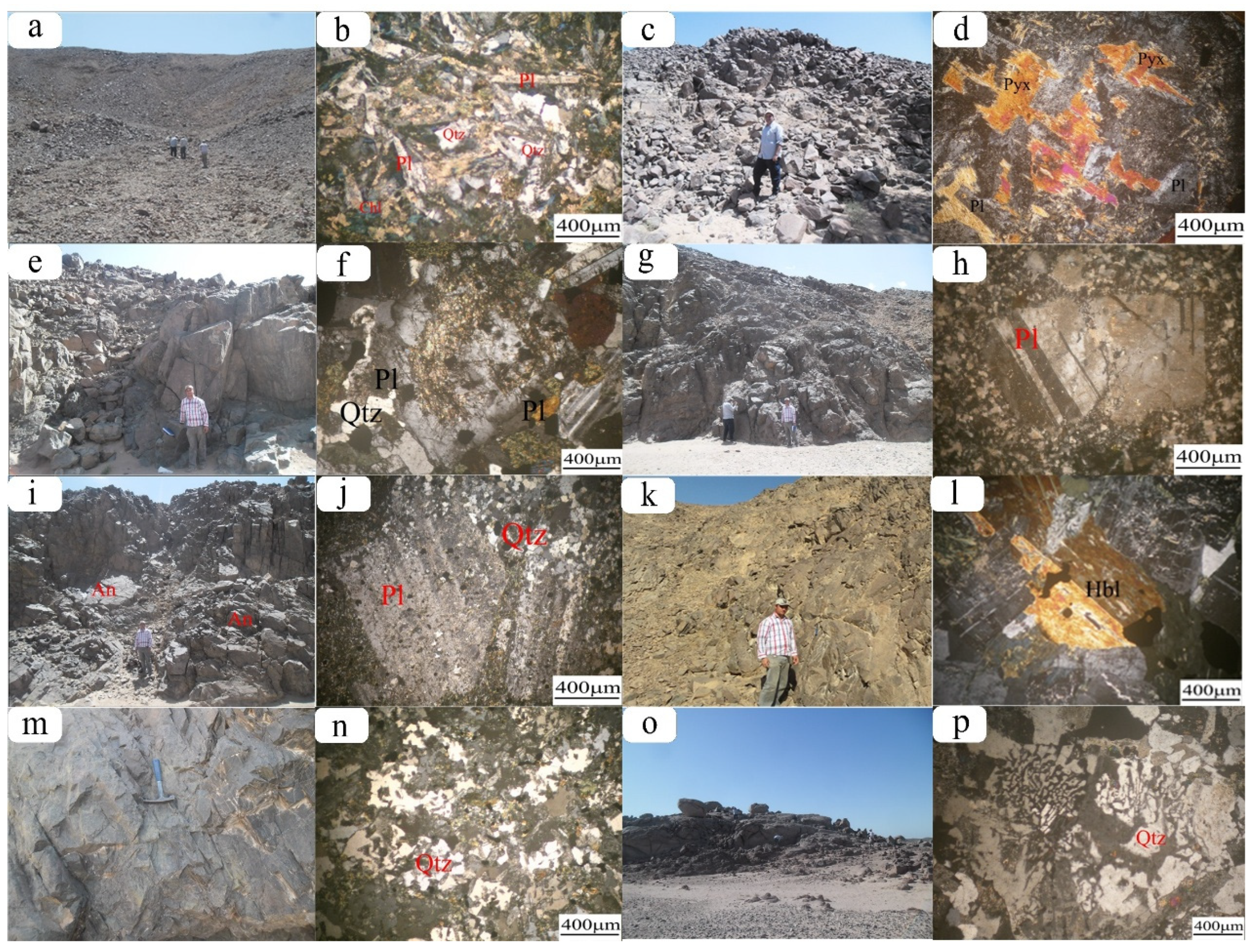
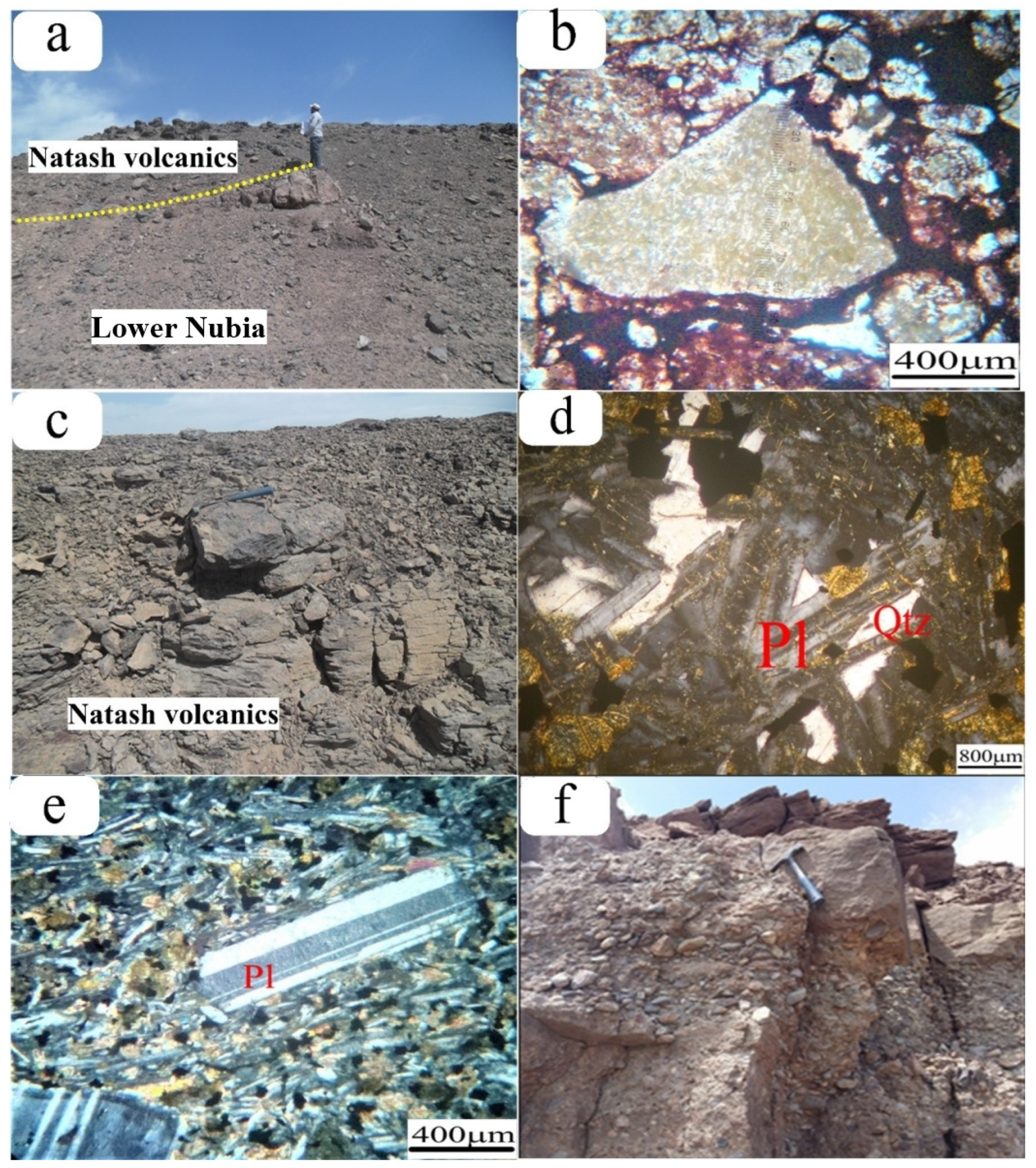
Disclaimer/Publisher’s Note: The statements, opinions and data contained in all publications are solely those of the individual author(s) and contributor(s) and not of MDPI and/or the editor(s). MDPI and/or the editor(s) disclaim responsibility for any injury to people or property resulting from any ideas, methods, instructions or products referred to in the content. |
© 2025 by the authors. Licensee MDPI, Basel, Switzerland. This article is an open access article distributed under the terms and conditions of the Creative Commons Attribution (CC BY) license (https://creativecommons.org/licenses/by/4.0/).
Share and Cite
El-Desoky, H.M.; Mohamed, W.H.; Shebl, A.; Fahmy, W.; El-Sherif, A.M.; Abdel-Rahman, A.M.; Mira, H.I.; El-Rahmany, M.M.; Alshehri, F.; Almadani, S.; et al. Integrating Remote Sensing and Aeromagnetic Data for Enhanced Geological Mapping at Wadi Sibrit-Urf Abu Hamam District, Southern Part of Nubian Shield. Minerals 2025, 15, 657. https://doi.org/10.3390/min15060657
El-Desoky HM, Mohamed WH, Shebl A, Fahmy W, El-Sherif AM, Abdel-Rahman AM, Mira HI, El-Rahmany MM, Alshehri F, Almadani S, et al. Integrating Remote Sensing and Aeromagnetic Data for Enhanced Geological Mapping at Wadi Sibrit-Urf Abu Hamam District, Southern Part of Nubian Shield. Minerals. 2025; 15(6):657. https://doi.org/10.3390/min15060657
Chicago/Turabian StyleEl-Desoky, Hatem M., Waheed H. Mohamed, Ali Shebl, Wael Fahmy, Anas M. El-Sherif, Ahmed M. Abdel-Rahman, Hamed I. Mira, Mahmoud M. El-Rahmany, Fahad Alshehri, Sattam Almadani, and et al. 2025. "Integrating Remote Sensing and Aeromagnetic Data for Enhanced Geological Mapping at Wadi Sibrit-Urf Abu Hamam District, Southern Part of Nubian Shield" Minerals 15, no. 6: 657. https://doi.org/10.3390/min15060657
APA StyleEl-Desoky, H. M., Mohamed, W. H., Shebl, A., Fahmy, W., El-Sherif, A. M., Abdel-Rahman, A. M., Mira, H. I., El-Rahmany, M. M., Alshehri, F., Almadani, S., & El-Awny, H. (2025). Integrating Remote Sensing and Aeromagnetic Data for Enhanced Geological Mapping at Wadi Sibrit-Urf Abu Hamam District, Southern Part of Nubian Shield. Minerals, 15(6), 657. https://doi.org/10.3390/min15060657







